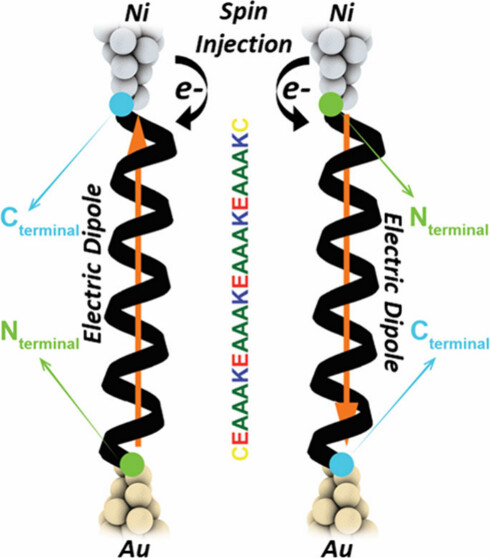We report on a remarkable phenomenon of interfacial electric dipole inversion coupled to changes in atomic spin densities that translates into the enantiomeric inversion of electron spin-dependent conductance in a 2-terminal single-molecule junction, consisting of a 22 amino acid chiral alpha-helical peptide sequence connecting two metal electrodes. This phenomenon is conventionally associated with the Chirality-Induced Spin Selectivity (CISS) effect and how it induces spin polarization and spin filtering of the electron transport along the main peptide axis. Here, the inversion of the spin-dependent charge transport behavior is achieved by keeping constant the chiral symmetry of the junction while inverting the direction of the internal electrical dipole moment running along the main helical peptide axis. Using a spinterface model, in which the electrode-molecule injection barriers are dependent both on the electric dipole and magnetic spin moment, we have been able to rationalize the current pattern as arising from a surface dipole inversion and changes in the atomic spin densities in atoms located within the peptide backbone. Both experimental and computational results show that the observed electric dipole-induced spin-dependent transport inversion in the chiral peptide junction links to an inversion in the spin-dependent resistance due to the combined effect of the helical-based CISS effect and the electrode/molecule spinterface.

We report on a remarkable phenomenon of interfacial electric dipole inversion coupled to changes in atomic spin densities that translates into the enantiomeric inversion of electron spin-dependent conductance in a 2-terminal single-molecule junction, consisting of a 22 amino acid chiral alpha-helical peptide sequence connecting two metal electrodes. This phenomenon is conventionally associated with the Chirality-Induced Spin Selectivity (CISS) effect and how it induces spin polarization and spin filtering of the electron transport along the main peptide axis. Here, the inversion of the spin-dependent charge transport behavior is achieved by keeping constant the chiral symmetry of the junction while inverting the direction of the internal electrical dipole moment running along the main helical peptide axis. Using a spinterface model, in which the electrode-molecule injection barriers are dependent both on the electric dipole and magnetic spin moment, we have been able to rationalize the current pattern as arising from a surface dipole inversion and changes in the atomic spin densities in atoms located within the peptide backbone. Both experimental and computational results show that the observed electric dipole-induced spin-dependent transport inversion in the chiral peptide junction links to an inversion in the spin-dependent resistance due to the combined effect of the helical-based CISS effect and the electrode/molecule spinterface.
